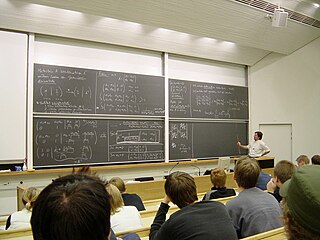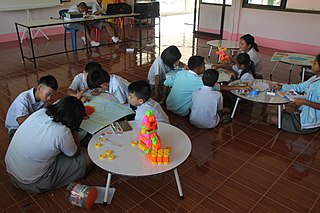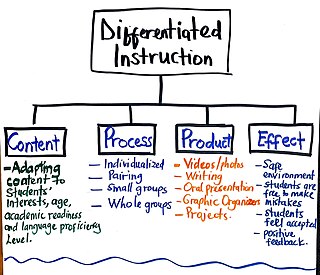Related Research Articles

A teacher, also called a schoolteacher or formally an educator, is a person who helps students to acquire knowledge, competence or virtue.

In contemporary education, mathematics education is the practice of teaching and learning mathematics, along with the associated scholarly research.
The Cecchetti method is variously defined as a style of ballet and as a ballet training method devised by the Italian ballet master Enrico Cecchetti (1850–1928). The training method seeks to develop essential skills in dancers as well as strength and elasticity. Cecchetti-trained dancers are commonly found in ballet and other dance companies throughout the world.
Blended learning, also known as hybrid learning, is an approach to education that combines online educational materials and opportunities for interaction online with traditional place-based classroom methods. It requires the physical presence of both teacher and student, with some elements of student control over time, place, path, or pace. While students still attend "brick-and-mortar" schools with a teacher present, face-to-face classroom practices are combined with computer-mediated activities regarding content and delivery. Blended learning is also used in professional development and training settings.
Electronic assessment, also known as digital assessment, e-assessment, online assessment or computer-based assessment, is the use of information technology in assessment such as educational assessment, health assessment, psychiatric assessment, and psychological assessment. This covers a wide range of activity ranging from the use of a word processor for assignments to on-screen testing. Specific types of e-assessment include multiple choice, online/electronic submission, computerized adaptive testing such as the Frankfurt Adaptive Concentration Test, and computerized classification testing.

The Texas Assessment of Knowledge and Skills (TAKS) was the fourth Texas state standardized test previously used in grade 3-8 and grade 9-11 to assess students' attainment of reading, writing, math, science, and social studies skills required under Texas education standards. It is developed and scored by Pearson Educational Measurement with close supervision by the Texas Education Agency. Though created before the No Child Left Behind Act was passed, it complied with the law. It replaced the previous test, called the Texas Assessment of Academic Skills (TAAS), in 2002.
Principles and Standards for School Mathematics (PSSM) are guidelines produced by the National Council of Teachers of Mathematics (NCTM) in 2000, setting forth recommendations for mathematics educators. They form a national vision for preschool through twelfth grade mathematics education in the US and Canada. It is the primary model for standards-based mathematics.

Project-based learning (PBL) is a student-centered pedagogy that involves a dynamic classroom approach in which it is believed that students acquire a deeper knowledge through active exploration of real-world challenges and problems. Students learn about a subject by working for an extended period of time to investigate and respond to a complex question, challenge, or problem. It is a style of active learning and inquiry-based learning. PBL contrasts with paper-based, rote memorization, or teacher-led instruction that presents established facts or portrays a smooth path to knowledge by instead posing questions, problems or scenarios.
Reflective practice is the ability to reflect on one's actions so as to take a critical stance or attitude towards one’s own practice and that of one's peers, engaging in a process of continuous adaptation and learning. According to one definition it involves "paying critical attention to the practical values and theories which inform everyday actions, by examining practice reflectively and reflexively. This leads to developmental insight". A key rationale for reflective practice is that experience alone does not necessarily lead to learning; deliberate reflection on experience is essential.
In education, Response to Intervention is an approach to academic intervention used in the United States to provide early, systematic, and appropriately intensive assistance to children who are at risk for or already underperforming as compared to appropriate grade- or age-level standards. RTI seeks to promote academic success through universal screening, early intervention, frequent progress monitoring, and increasingly intensive research-based instruction or interventions for children who continue to have difficulty. RTI is a multileveled approach for aiding students that is adjusted and modified as needed if they are failing.

Teacher education or teacher training refers to the policies, procedures, and provision designed to equip (prospective) teachers with the knowledge, attitudes, behaviors, and skills they require to perform their tasks effectively in the classroom, school, and wider community. The professionals who engage in training the prospective teachers are called teacher educators.
English-Language Learner is a term used in some English-speaking countries such as the US and Canada to describe a person who is learning the English language and has a native language that is not English. Some educational advocates, especially in the United States, classify these students as non-native English speakers or emergent bilinguals. Various other terms are also used to refer to students who are not proficient in English, such as English as a Second Language (ESL), English as an Additional Language (EAL), limited English proficient (LEP), Culturally and Linguistically Diverse (CLD), non-native English speaker, bilingual students, heritage language, emergent bilingual, and language-minority students. The legal term that is used in federal legislation is 'limited English proficient'. The instruction and assessment of students, their cultural background, and the attitudes of classroom teachers towards ELLs have all been found to be factors in the achievement of these students. Several methods have been suggested to effectively teach ELLs, including integrating their home cultures into the classroom, involving them in language-appropriate content-area instruction early on, and integrating literature into their learning programs.
Gifted Education in public schools is mandated by Georgia law and is governed by the Georgia Board of Education (GBOE) Rule 160-4-2-.38 and GBOE-approved regulations. The GBOE Gifted Education Rule was initiated November 13, 1997, reinitiated January 8, 1998 and then adopted on February 12, 1998 in the final form.
Connected Mathematics is a comprehensive mathematics program intended for U.S. students in grades 6-8. The curriculum design, text materials for students, and supporting resources for teachers were created and have been progressively refined by the Connected Mathematics Project (CMP) at Michigan State University with advice and contributions from many mathematics teachers, curriculum developers, mathematicians, and mathematics education researchers.
The National Board for Professional Teaching Standards (NBPTS) is a nonpartisan, nonprofit organization in the United States. Founded in 1987, NBPTS develops and maintains advanced standards for educators and offers a national, voluntary assessment, National Board Certification, based on the NBPTS Standards. As of December 2017, more than 118,000 educators have become National Board Certified Teachers in the United States. Its headquarters is located in Arlington, Va.

Reading is the process of taking in the sense or meaning of letters, symbols, etc., especially by sight or touch.

Differentiated instruction and assessment, also known as differentiated learning or, in education, simply, differentiation, is a framework or philosophy for effective teaching that involves providing all students within their diverse classroom community of learners a range of different avenues for understanding new information in terms of: acquiring content; processing, constructing, or making sense of ideas; and developing teaching materials and assessment measures so that all students within a classroom can learn effectively, regardless of differences in their ability. Differentiated instruction, according to Carol Ann Tomlinson, is the process of "ensuring that what a student learns, how he or she learns it, and how the student demonstrates what he or she has learned is a match for that student's readiness level, interests, and preferred mode of learning." According to Boelens et al. (2018), differentiation can be on two different levels. 1. The administration level which takes the socioeconomic status, and gender into consideration and 2. The classroom level. At the classroom level, differentiation revolves around content, processing, product, and effects. On the content level, teachers adapt what they are teaching to meet the needs of students. This can mean making content more challenging or simplified for students based on their levels. The process of learning can be differentiated as well. Teachers may choose to teach individually at a time, assign problems to small groups, partners or the whole group depending on the needs of the students. By differentiating product, teachers decide how students will present what they have learnt. This may take the form of videos, graphic organizers, photo presentations, writing, and oral presentations. All these takes place in a safe classroom environment where students fell repeated and values - effects.
Robert J. Marzano is an educational researcher in the United States. He has done educational research and theory on the topics of standards-based assessment, cognition, high-yield teaching strategies, and school leadership, including the development of practical programs and tools for teachers and administrators in K-12 schools.

Teacher leadership is a term used in K-12 schools for classroom educators who simultaneously take on administrative roles outside of their classrooms to assist in functions of the larger school system. Teacher leadership tasks may include but are not limited to: managing teaching, learning, and resource allocation. Teachers who engage in leadership roles are generally experienced and respected in their field which can both empower them and increase collaboration among peers.
Data-driven instruction is an educational approach that relies on information to inform teaching and learning. The idea refers to a method teachers use to improve instruction by looking at the information they have about their students. It takes place within the classroom, compared to data-driven decision making. Data-driven instruction works on two levels. One, it provides teachers the ability to be more responsive to students’ needs, and two, it allows students to be in charge of their own learning. Data-driven instruction can be understood through examination of its history, how it is used in the classroom, its attributes, and examples from teachers using this process.
References
- ↑ "The Labour Party's Manifesto 1997". BBC News 'Election 97' website. British Broadcasting Corporation. 1997. Archived from the original on March 5, 2008. Retrieved 2009-01-09.
- 1 2 School Teachers' Review Body (2001). "Development of the pay and career structures". School Teachers' Review Body Tenth Report. The Stationery Office. Retrieved 2009-01-09.
- ↑ Blake, D.; Hanley, V.; Jennings, M.; Lloyd, M. (2000). "`Superteachers': The views of teachers and head teachers on the Advanced Skills Teacher grade" (PDF). Research in Education. Manchester University Press. Retrieved 2009-01-09.[ permanent dead link ]
- ↑ "'Super-teachers' to receive super salaries". BBC News website. British Broadcasting Corporation. 1998-03-02. Retrieved 2009-01-09.
- ↑ "The Education (Grants for Education Support and Training) (England) Regulations 1998 (Amendment) Regulations 1998". OPSI website. Office of Public Sector Information. 1998. Retrieved 2009-01-09.
- 1 2 "Advanced Skills Teachers: Promoting Excellence". The Standards Site. Department for Children, Schools and Families. Archived from the original on 2008-12-18. Retrieved 2009-01-09.
- ↑ "Frequently asked questions: Advanced Skills Teachers". Teachernet Website. Department for Children, Schools and Families. 2006. Archived from the original on 2008-08-04. Retrieved 2009-01-09.
- 1 2 "School Teachers' Pay and Conditions Document" (PDF). The Stationery Office. 2008. Archived from the original (PDF) on 2009-04-19. Retrieved 2009-01-09.
- ↑ "Advanced Skills Teacher (AST): Application for assessment for main scale teachers" (PDF). Department for Children, Schools and families. Archived from the original (PDF) on 2008-07-02. Retrieved 2009-01-09.
- ↑ "School Teachers' Review Body Thirteenth Report – Part 2" (PDF). The Stationery Office. 2004. Archived from the original (PDF) on 2008-07-01. Retrieved 2009-01-09.